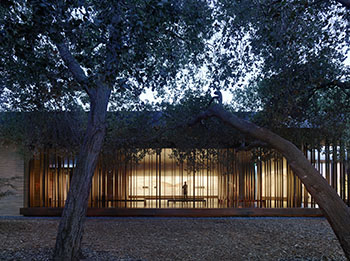Peaceful Oasis Built for Stanford University
 STANFORD, Calif. — The Windhover Contemplative Center, which was completed in October 2014, stands in stark contrast to the rest of the bustling Stanford University Campus in Stanford, Calif. Designed by Aidlin Darling Design of San Francisco, the center serves as a spiritual retreat for students, faculty and staff, and is designed to promote personal renewal and wellbeing.
STANFORD, Calif. — The Windhover Contemplative Center, which was completed in October 2014, stands in stark contrast to the rest of the bustling Stanford University Campus in Stanford, Calif. Designed by Aidlin Darling Design of San Francisco, the center serves as a spiritual retreat for students, faculty and staff, and is designed to promote personal renewal and wellbeing.
Spanning 4,000 square feet, the one-story Windhover Contemplative Center was inspired by the work of renowned artist Nathan Oliveira, whose Windhover series included both small drawings and massive oil paintings. The Aidlin Darling Design team also partnered with Andrea Cochran Landscape Architect of San Francisco “to create a space where art, landscape and architecture come together to replenish and invigorate the spirit,” according to a statement by the firm.
Equal parts spiritual sanctuary, art gallery and contemplative garden, the center has become a showcase piece for the university, and creates a peaceful island in the heart of the campus.
“In a world culture that focuses on speed and instantaneous access, Stanford has gifted their students and faculty a place to re-center themselves and find balance in their lives,” said Joshua Aidlin, founding partner of Aidlin Darling Design, in a statement. “There isn’t a person in the world that wouldn’t benefit from taking time each day to focus on true contemplation. The creation of a non-denominational space inspired by art and nature to practice mindfulness is rare. This new program type could be a paradigm shift for campuses and institutions around the country."
Visitors enter the center via a long, private garden buffered from the rest of the campus by soaring bamboo. Rammed earth walls, dark wood and plenty of natural light characterize the building’s inner spaces, which provide both views of the surrounding oak grove as well as an opportunity to sit and reflect on several of Oliveira’s sprawling works. Skylights serve as the building’s primary light source, and the space is scattered with comfortable cushions and benches where visitors can rest and reflect.
Designers strategically used water throughout the building and grounds as a meditation aid. There are fountains both indoors and out, and a reflecting pool and garden on the center’s southern side provide a peaceful mirror image of the surrounding vegetation, strengthening the building’s connection to nature.
These courtyards, coupled with the expansive glass wall to the east, allow visitors to view the paintings without accessing the building, effectively creating a sanctuary for the Stanford community day and night, according to a statement by Aidlin Darling.
“Working closely with Aidlin Darling Design from the outset, we envisioned the building and landscape as fully integrated,” said Andrea Cochran, principal of Andrea Cochran Landscape Architecture, in a statement. “This holistic approach shaped nearly every aspect of the design, from the carefully choreographed entry sequence; to the visual and physical permeability between the architecture and the landscape; to the interplay between the building materials, light, and shadow. By blurring the boundaries between inside and outside, the center provides a spiritual refuge and a rich new way to experience art and nature.”
Though the Windhover Contemplative Center primarily serves members of the Stanford University campus, the building is also open to the general public once a week during a docent-led tour.
